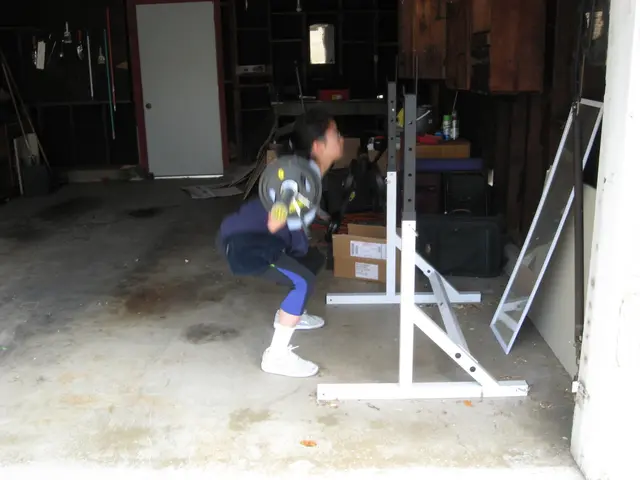Set up a straightforward and efficient workout schedule for home exercise
A guide for establishing an effective home workout routine is presented, catering to those seeking fitness without the need for gym memberships or expensive equipment. This approach involves combining bodyweight exercises, strength training, cardio, and flexibility workouts to develop a balanced fitness plan.
Setting Fitness Goals
The first step in creating a personalized workout routine is defining clear goals. Questions to consider include weight loss, muscle building, endurance improvement, flexibility enhancements, or overall health and wellness. Aligning these objectives with the chosen exercises and intensity levels is crucial.
Selecting the Right Exercises
A comprehensive home workout routine encompasses bodyweight exercises, cardio activities, and stretching for flexibility.
- Strength Training: Strengthen muscles and enhance overall strength through bodyweight exercises like push-ups, squats, lunges, planks, and glute bridges.
- Cardio Exercises: Improve heart health and burn calories through jumping jacks, high knees, jump rope, burpees, and stair climbing.
- Flexibility & Mobility: Stretching and mobility exercises, such as neck stretches, shoulder rolls, hamstring stretches, hip flexor stretches, and cat-cow stretches, help prevent injuries and improve flexibility.
Structuring the Weekly Workout Plan
To maintain consistency, follow a weekly workout schedule. An example structure consists of:
- Monday: Strength Training (Upper Body Focus)
- Tuesday: Cardio Workout
- Wednesday: Strength Training (Lower Body Focus)
- Thursday: Mobility and Stretching
- Friday: Full-Body Strength and Cardio Circuit
- Saturday: Light Cardio or Yoga
- Sunday: Rest or Active Recovery
Staying Motivated and Tracking Progress
To maintain consistency with workouts:
- Set realistic, achievable goals.
- Keep a workout journal, tracking reps, sets, and improvements.
- Mix up workouts to avoid boredom and maintain motivation.
- Utilize fitness apps for guided workouts and accountability.
- Find a workout buddy for mutual motivation and commitment.
Accounting for Nutrition and Recovery
Exercise is only one aspect of the overall fitness equation. Proper nutrition and recovery are equally important.
- Eat a balanced diet, including proteins, healthy fats, and complex carbohydrates.
- Stay hydrated by drinking ample water before and after workouts.
- Prioritize rest to avoid burnout and injuries.
- Aim for 7-9 hours of quality sleep each night.
In conclusion, establishing a home workout routine requires defining fitness goals, choosing appropriate exercises, structuring a weekly routine, staying motivated, tracking progress, and accounting for nutrition and recovery. By following these steps, individuals can create a comprehensive and enjoyable home fitness plan customized to their needs and objectives.
- A balanced fitness plan can be obtained without a gym membership or expensive equipment by following a home workout routine.
- Defining clear fitness goals is essential in creating a personalized workout routine, such as weight loss, muscle building, endurance improvement, or overall health and wellness.
- A comprehensive home workout routine should include bodyweight exercises, cardio activities, and stretching for flexibility.
- Strength Training involves exercising with bodyweight to strengthen muscles and enhance overall strength through movements like push-ups, squats, lunges, planks, and glute bridges.
- Cardio exercises can improve heart health and aid in calorie burning by performing activities like jumping jacks, high knees, jump rope, burpees, and stair climbing.
- Flexibility and mobility can be improved through stretching and mobility exercises, such as neck stretches, shoulder rolls, hamstring stretches, hip flexor stretches, and cat-cow stretches.
- Consistency in a workout routine can be maintained through following a weekly schedule, including strength training sessions for upper and lower body, cardio workouts, mobility and stretching, light cardio or yoga, and rest or active recovery days.
- To stay motivated in workouts, set realistic goals, keep a workout journal, mix up workouts to avoid boredom, use fitness apps for guided workouts and accountability, and find a workout buddy.
- Proper nutrition and recovery are crucial components of the overall fitness equation. A balanced diet rich in proteins, healthy fats, and complex carbohydrates should be consumed, and ample water should be drunk before and after workouts. It's important to prioritize rest, aiming for 7-9 hours of quality sleep each night, to avoid burnout and injuries.
- Yoga can serve as a light cardio option or a way to increase flexibility and mobility.
- The science of fitness and health-and-wellness, as well as fitness-and-exercise, should be considered in developing a comprehensive and enjoyable home fitness plan tailored to individual needs and objectives.






